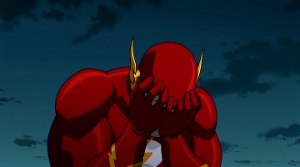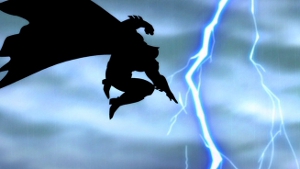Tag Archives: Jay Oliva
Justice League: War (2014)
Doctor Strange (2007)
Justice League: The Flashpoint Paradox (2013)

As I said in the Superman Unbound review, DC Comics uber-writer Geoff Johns got his job thanks to his love of those first two live-action Superman films (and The Goonies). Because of this, he talked himself into a job playing step-n-fetch-it for director Richard Donner. Because of this, young Geoff found time to make some friends at DC Comics while he and Donner were in New York, working on that Mel Gibson-led X-Files rip-off no one remembers anymore, Conspiracy Theory.
Within a few months, former Superman writer (now DC Group Editor) Eddie Berganza secured Johns a job penning Justice Society of America. “Written” at the time (though some of us suspected it was “written in name only”) by Notable Hollywood Screenwriter David S. Goyer, JSA evolved, under Johns tenure, into an occasionally-quite-nice microcosm of its home universe. While the modern Justice League is usually composed of characters with true cultural clout, instantly recognizable to even the least-literate among us, JSA thrived by combining characters from comic’s Golden Age with impetuous youngsters either inspired by their example or straight-up continuing some poor dead person’s legacy.
That’s the thing I’ve always liked about the DC Universe: a meta-textual awareness of its own history. Unlike Marvel Comics, where all roads lead back to Captain America and everything else gets shunted a decade or so down the time stream by Editorial Fiat whenever continuity headaches become epidemic, DC’s heroes come in distinct, generational blocks. The Old Guard started putting on masks and punching bad guys at some point in the mid-1920s. They did it for their own reasons, came together for World War II, and then drifted apart again for other reasons no writer seems interested in addressing, save obliquely, through peeks at Wacky Alternate Dimensions (like the Watchmen universe, which outlawed masked heroics in the 70s with its Keene Act). The New Guard of the “perma-modern” world, usually beginning with Superman, chose to go the “thong-and-blanket” route partially because of that preexisting heroic tradition. This adds historical depth to DC’s fictional world while eliminating the need for any one character to bare the full weight of being “the world’s first super-hero” (though Superman’s usually handed that title by sympathetic friends in the media). Continue reading Justice League: The Flashpoint Paradox (2013)
Batman: The Dark Knight Returns, Part 2 (2013)
Part 4: More Comic Book History You Don’t Care About But Need to Know in Order to Understand What the Hell’s Going On in This Review:

Since Warner Brothers insisted on adapting this story into two, one hour and twelve minute movies, I made a point of not revisiting The Dark Knight Returns, Part 1 in preparation for this review of Part Deux. If it’d been up to me, I would’ve adapting Frank Miller’s four-issue story arc into one movie, and I might just edit these two together at some point, when I get some spare time. Even with everything here, it’d still be at least an hour shorter than the last two live action Bat-films. And make no mistake – the WB’s straight-to-video animation department threw in a lot.
They had no choice. These are adaptions of one of the best-loved Batman stories in history. Find me a Bat-writer and, with a little help from my friend Google, I’ll probably be able to find you a choice quote about how 1986’s Dark Knight Returns either got them into Batman in the first place, or brought them back after a period of apostasy. Current Batman/Superman writer Greg Pak just provided me a perfect example in this interview, dated February 27th, 2013:
I dropped out for a little bit, and I was still picking up indie comics like Cerebus and Usagi Yojimbo, but it was Batman that got me back into superhero comics when I was in college. Specifically it was Dark Knight Returns and Batman: Year One, which then led me to other stuff. It was basically Frank Miller who dragged me back in, and I was hooked. I was obsessed with Batman. Continue reading Batman: The Dark Knight Returns, Part 2 (2013)
Batman: The Dark Knight Returns, Part 1 (2012)
Introduction: Comic Book History You Don’t Care About But Need to Know in Order to Understand What the Hell’s Going On (with apologies to Linkara).

Yes, friends, it’s time once again to examine the hilariously over-praised work of comic book writer Frank Miller, whose slow slide into insanity, inanity and irrelevance has provided amusement to comic book fans for the last fifteen years. Before that, though – and still to this day in some corners of Bat-fandom – Miller is/was considered a godhead, the wellspring from which all modern conceptions of Batman flow.
This is patent bullshit, ignoring at least fifteen years of hard work by other creatives. My favorite Batman editor, Dennis O’Neil, started out as a front-line writer in 1969, and made the conscious choice to move Bats away from the campiness of his by-then-canceled TV show. Together with writer/artist Neil Adams, inker Dick Giordano and editor Julius Schwartz, O’Neil returned The Bat to his roots in the pulpy Crime Dramas of the 30s and early 40s. The SF elements common in American comic’s Silver Age either shuffled off to the background…or were not-so-subtly twisted to reflect the changing (or “evolving”…and I’d dare say “improving”) tastes of the 70s. This culminated in Steve Englehart and Marshall Rogers 1977 run on Detective Comics, now sold under the title Batman: Strange Apparitions.
For my cash, that marks the first appearance of a truly “modern” Batman, complete with all the baggage and angst that define him still today. O’Neil sent the First Robin, Dick Grayson, off the college, leaving Bats and Alfred alone in their mansion, just the way filmmakers (apparently) like it. Englehart and Rogers introduced the first of many Bruce Wayne love interests, inevitably moving him to question his crusade and its end game…before just as inevitably departing his life, leaving him with even more to brood about. Put those elements together, shake ’em up, add villains to taste, and you’ve got every (good) live action Bat-film to date…and through Batman’s influence, most of the Superhero sub-genre.
Continue reading Batman: The Dark Knight Returns, Part 1 (2012)
